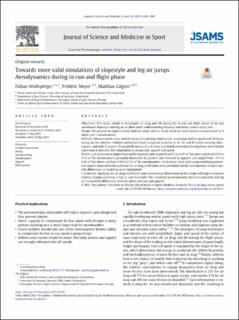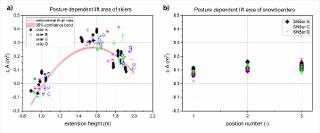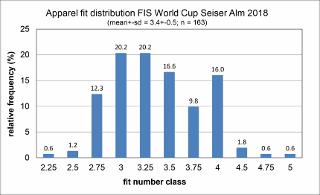| dc.contributor.author | Wolfsperger, Fabian | |
| dc.contributor.author | Meyer, Frédéric | |
| dc.contributor.author | Gilgien, Matthias | |
| dc.date.accessioned | 2021-12-10T12:46:09Z | |
| dc.date.available | 2021-12-10T12:46:09Z | |
| dc.date.created | 2021-06-11T13:35:40Z | |
| dc.date.issued | 2021 | |
| dc.identifier.citation | Journal of Science and Medicine in Sport. 2021, 24(10), 1082-1087. | en_US |
| dc.identifier.issn | 1440-2440 | |
| dc.identifier.uri | https://hdl.handle.net/11250/2833808 | |
| dc.description | This is an open access article under the CC BY-NC-ND license (http://creativecommons.org/licenses/by-nc-nd/4.0/). | en_US |
| dc.description.abstract | Objectives: This study aimed to investigate air drag and lift during the in-run and flight phase of ski and snowboard slopestyle and big air, to allow more valid modeling of jumps and hence reduce injury risk.
Design: We present an experimental, multiple single athlete study based on wind tunnel measurements of 4 skiers and 3 snowboarders.
Methods: Measurements were carried out in a closed loop wind tunnel, measuring airflow speed and 3D forces acting on the athletes. Athletes performed trials in typical postures at 35, 60 and 85 km/h wearing slim-, regular- and wide fit apparel. Drag and lift area (cDA; cLA) were calculated and analyzed using linear and multiple regression to describe their dependencies on posture, apparel and speed.
Results: cDA values were higher than earlier assumed and ranged from 0.3 to 0.95 m2 for skiers and from 0.35 to 0.55 m2 for snowboarders, primarily dominated by posture, and followed by apparel. cLA ranged from −0.1 to 0.45 m2 for skiers and from 0.04 to 0.17 m2 for snowboarders. To facilitate more valid jump modeling posture- and apparel-dependent formulations for air drag coefficients were provided and the consequences of sport specific differences on modeling were highlighted.
Conclusions: Applying the air drag coefficients and relationships determined in this study will help to improve validity of jump modeling in big air and slopestyle. The variability in aerodynamic forces in slopestyle and big air is caused by differences between sports, posture and apparel. | en_US |
| dc.language.iso | eng | en_US |
| dc.subject | accident prevention | en_US |
| dc.subject | aerodynamics | en_US |
| dc.subject | apparel | en_US |
| dc.subject | body posture | en_US |
| dc.subject | skiing | en_US |
| dc.subject | snowboarding | en_US |
| dc.title | Towards more valid simulations of slopestyle and big air jumps: Aerodynamics during in-run and flight phase | en_US |
| dc.type | Peer reviewed | en_US |
| dc.type | Journal article | en_US |
| dc.description.version | publishedVersion | en_US |
| dc.rights.holder | © 2021 The Authors | en_US |
| dc.source.pagenumber | 1082-1087 | en_US |
| dc.source.volume | 24 | en_US |
| dc.source.journal | Journal of Science and Medicine in Sport | en_US |
| dc.source.issue | 10 | en_US |
| dc.identifier.doi | 10.1016/j.jsams.2021.05.005 | |
| dc.identifier.cristin | 1915287 | |
| dc.description.localcode | Institutt for fysisk prestasjonsevne / Department of Physical Performance | en_US |
| cristin.ispublished | true | |
| cristin.fulltext | original | |
| cristin.qualitycode | 1 | |


